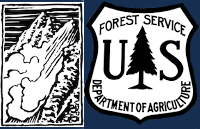20-21
The Upper Yellowstone Snowmobile Club worked with the Friends of GNFAC to install two new Beacon Checkers near Cooke City. One is located on the north edge of town as you leave on Miller Rd. The second is at the intersection of Lulu Pas Road and the road to Round Lake. Photo (and assembly): B. Zavora
**Please note, these checkers are not a substitute for formal daily transceiver checks with your entire group. They are there as a reminder. It is important to ensure all of your group member's transceivers have full batteries, and their transmit and search functions work properly.
The Upper Yellowstone Snowmobile Club worked with the Friends of GNFAC to install two new Beacon Checkers near Cooke City. One is located on the north edge of town as you leave on Miller Rd. The second is at the intersection of Lulu Pas Road and the road to Round Lake.
**Please note, these checkers are not a substitute for formal daily transceiver checks with your entire group. They are there as a reminder. It is important to ensure all of your group member's transceivers have full batteries, and their transmit and search functions work properly. Photo (and assembly): B. Zavora
Forecast link: GNFAC Avalanche Forecast for Fri Dec 18, 2020
Small, intentionally triggered slide
Road cut south facing slope of 42 degrees, triggered intentionally, shows about 12 inches of windblown soft slab on top of a faceted layer (in this case more extreme due to aspect and inclination toward the sun) but was triggered only by chopping a hand into the snow a few times. This same faceted layer (the uppermost layer of a thick faceted layer of 1-2 fee) exists throughout the snowpack. Also, the bottom-most layers of snow are very faceted and conditions have not occurred yet to set the snow for a base. Walking around your feet go right to the ground even in areas where snow is 2+ feet deep. There are many rock/tree hazards lurking under the soft snow because of this, two people in our group damaged their a-arms.
GNFAC Avalanche Forecast for Thu Dec 17, 2020
<p>The 2-3 foot deep snowpack in the mountains south of Big Sky to West Yellowstone consists of mostly weak, faceted, sugary snow. Every day over the last 6 days snow has fallen and the winds have blown (<a href="https://www.mtavalanche.com/weather/wx-avalanche-log"><strong><u>wx log</u></strong></a>). This incremental loading is creating instability. I was in the Lionhead area over the last 2 days and found very weak snow (<a href="https://www.youtube.com/watch?v=N2PYLeN5iUc"><strong><u>video</u></stro…;). Yesterday, I was able to avalanche a small sidehill that was wind-loaded (<a href="https://www.mtavalanche.com/images/20/soft-slab-avalanche-side-hill"><s…;), another skier saw a small avalanche on the Fawn Pass/Bighorn loop in YNP (<a href="https://www.mtavalanche.com/node/23266"><strong><u>details</u></strong>…;), and a sledder got the weak layer to propagate/fracture in his stability tests on the heavily wind-loaded Two Top Mountain (<a href="https://youtu.be/eV2t2EVYnbk"><strong><u>video</u></strong></a>). These red flags are evidence of a rising instability, especially on wind-loaded slopes. Avalanches, shooting cracks and whumpfs are signs to recreate elsewhere. </p>
<p>The avalanche danger is rated CONSIDERABLE on wind-loaded slopes and MODERATE on all others.</p>
<p>The northern ranges received 1” of snow and strong west to southwest wind. The snowpack is mostly thin (2 feet or less) and weak. Sugary, faceted snow is the overwhelming theme. Wind-loaded slopes at ridgetops or gullies are where increased avalanche danger lurks. Dave and Ian show us this recipe in Tuesday’s <a href="https://www.youtube.com/watch?v=JrjrgTLRff0"><strong><u>video</u></stro…; north of Bridger Bowl. We are finding the same snowpack structure and recipe for avalanches throughout the Bridger, northern Gallatin and northern Madison Ranges (<a href="https://www.youtube.com/playlist?list=PLXu5151nmAvQDzKmH5K3ZS8Gg3DzwsZ3… playlist</u></strong></a>). </p>
<p>Snow storms have been small with only a few inches falling at a time. This incremental loading is slowly building a slab which is becoming unstable on wind-loaded slopes. Both Big Sky and Bridger Ski Areas have a snowpack similar to the backcountry and they are getting avalanches with explosives. Additionally, skiers in Beehive Basin are getting unstable test scores, a first of the season and a telling sign of future problems. Be careful traveling onto wind-loaded slopes and retreat if you get cracks shooting out from your skis or sled, or feel a whumpf. Today the avalanche danger is rated MODERATE on wind-loaded slopes and LOW on all other slopes.</p>
<p>Cooke City got 4” of snow (.3” <a href="https://www.nrcs.usda.gov/wps/portal/nrcs/detail/or/snow/?cid=nrcs142p2… water equivalent</u></a>) and moderate southwest wind. The snowpack here lacks widespread weak layers and is 4-5 feet deep, but current wind-loading will create drifts which could be triggered. A foot of snow that fell in the last 7 days is being blown around. Drifts could be a couple feet thick and should be avoided. Shooting cracks are signs of instability and a warning to go play on a non-wind-loaded slope. For today, the avalanche danger is rated MODERATE on wind-loaded slopes and LOW on all other slopes.</p>
<p>If you get out, please send us your observations no matter how brief. You can submit them via our <a href="https://www.mtavalanche.com/node/add/snow_observation"><strong><u>websi…;, email (<a href="mailto:mtavalanche@gmail.com"><strong><u>mtavalanche@gmail.com</u></str…;), phone (406-587-6984), or Instagram (#gnfacobs).</p>
Upcoming Avalanche Education and Events
See our education calendar for an up to date list of all local classes. Here are a few select upcoming events and opportunities to check out:
Small natural avalanche at Bighorn/Fawn Pass loop
I went on a ski around the Bighorn/Fawn Pass loop today, and had some unfortunate, but unsurprising observations. There was about 30-60 cm of snow on the ground, which consisted of a low-density slab sitting on top of unconsolidated, sugary facets. Each step forward on skis gave little resistance as I sank all the way to the ground. I observed one small, recent avalanche on a wind-loaded north aspect at 7800’, which clearly failed at the new snow/facet interface (the base is so rotten here there was an obvious difference in tone between the layers). Only one Meadow gave an audible whumph for me, but I imagine that will become more common as we get a little more SWE in the coming days. Light snowfall and moderate winds were creating drifts surprisingly quickly.
